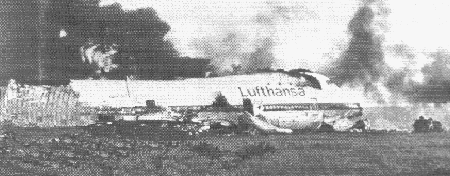Date: November 20th, 1974
Type: 747
Registration: -
Operator: Lufthansa
Flight No. LH540/19
Where: Nairobi Airport, Kenya
Report No.: Not Available
Report Date: July 1976
Pages: -


Nairobi Tower: "Lufthansa five four zero. Nairobi Tower" Co-pilot Schacke: "Five four zero, go ahead" Nairobi Tower: "Roger. You may take runway two-four at your discretion or runway zero-six. Your choice." Captain Krack: "Oh-two-four, okay" Co-pilot Schacke: "We take two-four" Nairobi Tower: "Roger. Cleared to taxi holding point, runway two-four." Co-pilot Schacke: "Roger. We are cleared to holding point, runway two-four. Are we cleared to enter?" Nairobi Tower: "Lufthansa five four zero. That is approved. Enter and backtrack." Co-pilot Schacke: "Roger. Thanks. Co-pilot Schacke: (to the Captain) "So the flaps" Captain Krack: "Yes" Co-pilot Schacke: "So, shall I do the rowing? (handle takeoff) Captain Krack: "Yes please" Flight Engineer Hahn: "Checklist, brakes" Co-pilot Schacke: "Are checked" Flight Engineer Hahn: "Flaps" Captain Krack: "Ten, ten, green." Flight Engineer Hahn: "Flight controls" (indistinct reply) Flight Engineer Hahn: "Yaw damper" Captain Krack: "Checked" Flight Engineer Hahn: "Flight instruments and annunciator panels" Captain Krack: "No warnings" Co-pilot Schacke: "No warnings here" The flight crew continued with the checklist... Captain Krack: "Cabin report received" Flight Engineer Hahn: "Checklist completed" Time 07.41 Nairobi Tower: "Lufthansa five four zero, your clearance" Co-pilot Schacke: "Go ahead" Nairobi Tower: "ATC clears Lufthansa five four zero Nairobi to Jan Smuts delta amber one zero. Climb and maintain flight level three five zero to Mike Bravo Mbeya Echo departure and check clearabnce expires at five six. Time is now five one" The crew completed the the take-off checklist. Flight Engineer Hahn: "Take-off list is completed" Co-pilot Schacke: "Okay" The throttles were set to the correctly calculated 3A take-off power and the 747 began to move forward down the runway. Co-pilot Schacke: "Eighty" Captain Krack: "Yes...Okay" Captain Krack: "V1" Captain Krack: "VR" Captain Krack: "Pay attention. Vibration...." Flight Engineer Hahn: "All is OK" Captain Krack: "Vibration" Co-pilot Schacke: "Gear up" Co-pilot Schacke: "Gear travelling" Flight Engineer Hahn: "Engines okay sot far" Captain Krack: "Roger" Flight Engineer Hahn: "RPM also okay" Flight Engineer Hahn: "Stickshaker" Co-pilot Schacke: "Okay, crash!" Wheels up warning horn began to sound.

The East African Community report was officially released in Nairobi in July 1976. A summary described the accident: The aircraft was operating Lufthansa flight 540/19, a scheduled international passenger and cargo service from Frankfurt, Germany, to Johanneburg, South Africa, with an intermediate stop at Nairobi. During the takeoff from Nairobi the crew felt vibration or buffeting after liftoff and suspected engine trouble. Subsequently the Commander, suspecting wheel impalance, raised the landing gear. The co-pilot, who was handling the aircraft, noticed a complete lack of acceleration and had to lower the nose in an attempt to maintain airspeed. The aircraft lost altitude and the rear fuselage made contact with the ground approximately 1120 metres beyond the departure end of runway 24. Parts of the aircraft struck an elevated road 114 metres further on and it started to break up. The main portion skidded an additional 340 metres during which time it turned to the left through approximately 180 degrees. The aircraft was destroyed by impact and subsequent fire. Cause: The accident was caused by the crew initiating a takeoff with the leading edge flaps retracted, because the pneumatic system which operates them had not been switched on. This resulted in the aircraft becoming airborne in a partially stalled condition which the pilots were unable to identify in the short time available to them for recovery. Major contributory factors were: 1. Lack of warning of a critical condition of leading edge flap position. 2. The failure of the crew to satisfactorily complete their checklist items. Recommendations It is recommended that: 1. The takeoff configuration aural warning system programme on Boeing 747 aircraft should be modified to include leading edge flap position. 2. The takeoff configuration aural warning system on Boeing 747 aircraft should be excluded from the list of allowable deficiencies. 3. Consideration should be given to the incorporation of leading edge flap position in the aircraft's stall warning programme. 4. Consideration be given to the incluslion of a pneumatic duct low pressure warning on the Pilot's Annunciatior Panel. 5. Consideration be given to amending operating procedures where necessary to include a cross-check by the Commander of important items on the flight engineer's panel. 6. In Boeing 747 and similar aircraft, States of Registry should require the carriage of a multi-channel flight data recorder compatible with ARINC 573 or equivalent characteristic. 7. In Boeing 747 and similar aircraft, consideration should be given by States of Registry to require the installation and use of hot microphone cockpit voice recorder circuits during the takeoff, approach and landing phases. 8. Implementation of adequate international incident reporting procedures, as initiated in the Accident/Incident Reporting System (ADREP) of the International Civil Aviation Organisation, including effective follow-up action, should be enforced.
![[747 Nairobi]](201174B.gif)